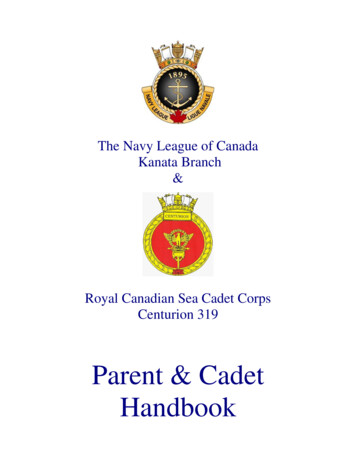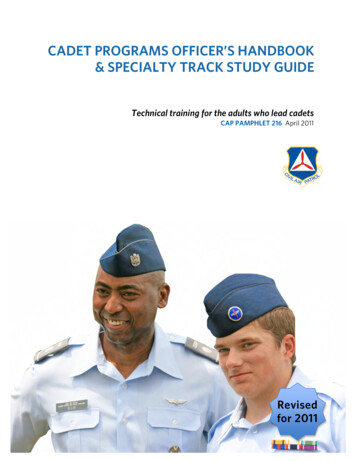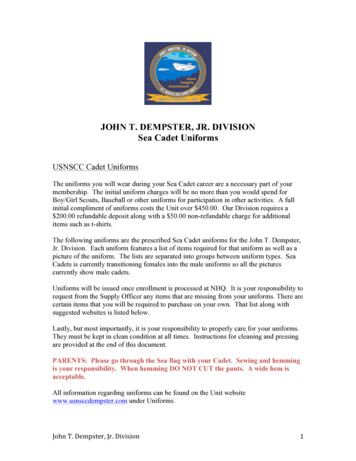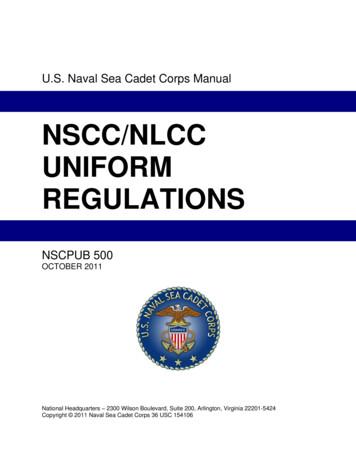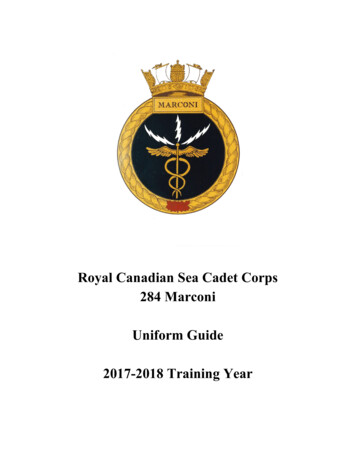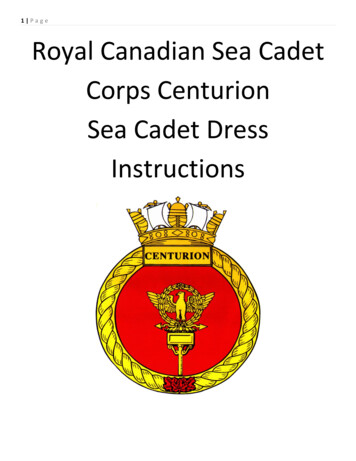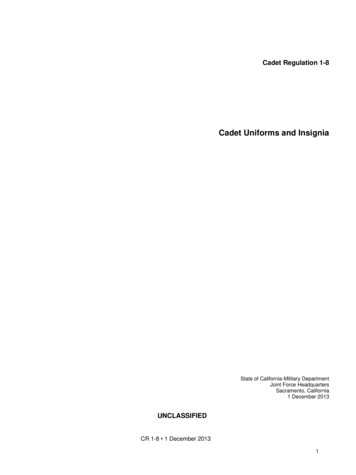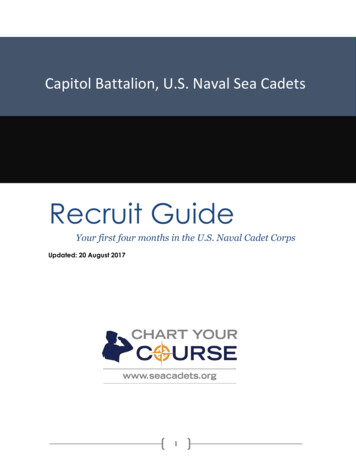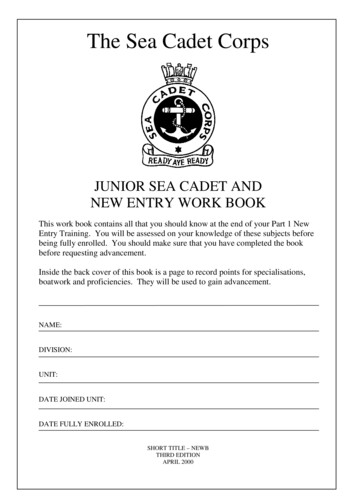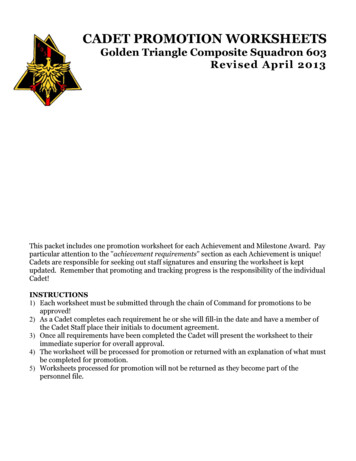
Transcription
CadetHandbookThe University ofSouthernMississippi
Table of ContentsSoldier’s Creed and Cadet CreedPage 2History of the Golden Eagle BattalionPage 3History of ROTCPage 3Military Science Program and SchoolsPage 4Military SchoolsPage 5Warrior Forge & Leadership Training CoursePage 6Army OrganizationPage 7Battalion StaffPage 10Chain of CommandPage 13Physical TrainingPage 14Leadership Lab and LDPPage 15LDP Process CyclePage 16Additional Cadet ActivitiesPage 17Mentorship ProgramPage 18Ranger ChallengePage 19Field Training ExercisePage 20Military CourtesyPage 21Appearance and GroomingPage 23UniformsPage 25AcronymsPage 33Phonetic AlphabetPage 34Army SongPage 36Troop Leading Procedures and AAR FormatPage 37Operation Order FormatPage 389 Line MEDEVAC Request FormatPage 39Cadet NotesPage 40
Page 2The Soldiers CreedI am an American Soldier.I am a Warrior and a member of a team.I serve the people of the United States and live the Army Values.I will always place the mission first.I will never accept defeat.I will never quit.I will never leave a fallen comrade.I am disciplined, physically and mentally tough, trained and proficientin my warrior tasks and drills.I always maintain my arms, my equipment and myself.I am an expert and I am a professional.I stand ready to deploy, engage, and destroy the enemies of theUnited States of America in close combat.I am a guardian of freedom and the American way of life.I am an American Soldier.The Cadet CreedI am an Army Cadet. Soon I will take an oath and become an Army Officer committed to defending the values which make this nation great.Honor is my touchstone. I understand mission first and people always.I am the past – the spirit of those warriors who have made the final sacrifice.I am the present – the scholar and apprentice soldier enhancing myskills in the science of warfare and the art of leadership.But above all, I am the future – the future warrior leader of the UnitedStates Army. May God give me the compassion and judgment to leadand the gallantry in battle to win.I will do my duty.
Page 3History of the Golden Eagle Battalion and ROTCSouthern MississippiMississippi Southern College Reserve Officer Training Corps (ROTC) wasactivated on April 3, 1950, as an Artillery unit by an act of Congress. Thefirst Professor of Military Science was LTC Harrison Finlayson. UnderLTC Finlayson's leadership, enrollment in the program increased to 232cadets by 1952. This was also the year the first class of cadets were commissioned as 2nd Lieutenants. There were 30 commissionees in theclass, of which four received commissions as Regular Army Officers. Alsoin 1952, a Military Ball washeld to honor the first commissioning class. The ballbecame an annual eventand is still held in honor forthe commissionees fromeach class.Throughout the 1950s and1960s the program thrived.Approximately 35 cadetswere commissioned eachyear. During those earlyyears, the ROTC programreceived tremendous support from the university administration. This was especially true while Dr. William McCain (Major General-retired) was presidentof Southern Miss from 1955 to 1975.Under COL Tommy Palmertree in 1982-1983, enrollment increased to2,053 from 1980's enrollment of 734. In 1982-1983, the Southern MissROTC Department was the largest ROTC unit in the nation.Reserve Officer Training CorpThe United States Army Reserve Officers' Training Corps (ROTC) as weknow it today dates from the National Defense Act of 1916. World War Iprevented the full development of civilian educators and military professionals working together. At the conclusion of World War I, the programwas fully implemented on college campuses. The success of this effortwas demonstrated in World War II, Korea, Vietnam and the Gulf War.College campuses provided quality officers to meet the rapidly expandingneeds of mobilization. In 1964 the ROTC Vitalization Act improved theprogram by adding scholarships.
Page 4Military Science Program and SchoolsBasic CourseMSL 100 and 200 level–These courses focus on the organization androle of the U.S. Army, rifle marksmanship, customs and courtesies, careeropportunities, land navigation, leadership laboratory, and field trainingexercises.Military SchoolsCadets have the option of attending training courses throughout theschool year. These courses include, but are not limited to:Airborne SchoolAir Assault SchoolMountain WarfareCadet Troop Leadership Training (CTLT)Nurse Summer Training Program (NSTP)Additional OpportunitiesCadets compete then selected to attend this excellent training based ontheir overall standing within the program. Selection for schools is basedoff of the OML. Cadets should request for attendance to schools throughtheir chain of command.Airborne school is a three-week program of instruction conducted atFort Benning, Georgia. The course is open tocontracted cadets MS II and above, who volunteer and pass the physical requirements. A minimum Physical Fitness score of 250 is required.At Airborne school, cadets will train along sideRegular Army officers and enlisted men andwomen, as well as members of the other armed services, to jump from anAir Force aircraft (C130 and C17). Upon completion of the course, cadetswill earn the coveted jump wings and be parachutist qualified! This courseis extremely safe and boosts the confidence of all who have the opportunity to attend.Air Assault school is 10 days of mental andphysical challenges. This school is designed toteach air assault skills and procedures, rappelling,sling load preparation, working with aircraft, improve basic leadership skills, instill the Air Assaultspirit and award the Air Assault Badge. Location of course will bepending.
Page 5Military SchoolsMountain Warfare School is a two-week course taught by the Vermont National Guard at Ethan Allen Firing Range in Jericho, Vermont. Both a summer and a winter phase are offered. The training isdesigned to make you an expert in mountain operations. MountainWarfare School is both physically and mentally demanding. Trainingis non-stop, 15 hours per day,for 14 days. If you can carry a65-pound rucksack up to fivemiles per day in mountainousterrain and are competent withboth day and night land navigation you may have what it takesto complete this intense training.Cadet Troop LeadershipTraining (CTLT) is a fourweek leadership experienceconducted at various unitsthroughout the ContinentalU.S., Alaska, Hawaii, Europeand Korea. Students areplaced in charge of a regular Army platoon of approximately 35 soldiers. The student's objective is to perform the leadership and management tasks necessary to train the platoon's soldiers and maintainits equipment. Opportunities from different branches of the Army areavailable to each school.Nurse Summer Training Program (NSTP) This course is availableonly to qualified nurse cadets. NSTP is an optional clinical electiveproviding opportunities to develop and practice leadership skills in aclinical environment. Nurse cadets train for three weeks at selectedU.S. Army Medical Command Medical Treatment Facilities. Cadetswork side-by-side with an Army Nurse Corps officer preceptor.Additional Opportunities: Other schools and courses that cadetscan attend include Culture Language Program (CULP), Drill CadetLeadership Training (DCLT), and Sapper School. For more information on these courses visit http://www.rotc.usaac.army.mil/
Page 6Warrior Forge & Leadership Training CourseLDAC/Warrior ForgeThe summer following your MS III year, all cadets attend the LeadershipDevelopment and Assessment Course (LDAC), a month long summercourse at Ft. Lewis, WA. It is designed to evaluate a cadet's leadershipabilities while providing additional leadership and individual skills instruction based on the knowledge gain through Military Science AdvancedCourses.During LDAC, cadets will receive an overall of six evaluations. They willhave 2 garrison evaluations, 1 FLRC evaluation, 2 SSTX evaluations, andone patrolling evaluation. These positions allow the cadet to demonstratehis/her leadership ability and skills. The cadet's performance in this area,along with scores from the Army Physical Fitness Test (APFT), land navigation test, and tactics, make up the cadet's final grade. During LDAC, acadet will be exposed to many areas of Army doctrine and skills. LDACalso features special training consisting of individual movement techniques, offensive and defensive operations, water survival, and more.Recondo CertificationExecute all confidence training presented to the prescribed standard.Score 270 or above on the Army Physical Fitness Test, without retest, with a minimum of 90 points per event.Achieve a score of 80 percent on written and practical Land Navigation proficiency tests without retest.Complete the following First Aid tasks to specified standards: CPR,evaluate a casualty, manage the airway, control bleeding.Receive satisfactory or higher in all garrison and field evaluationsThe evaluation a cadet receives has an effect on his/her future rolein the U.S. Army. For this reason, cadets should put forth their maximumeffort and be fully prepared. All material required will be covered during acadet's training in Army ROTC, so the cadet must ensure that he/she isready to lead the way.LTCLeader's Training Course (LTC) is the Army’s 2-year ROTC Program entry point. Through the Leader's Training Course, students without ROTCBasic Course experience can examine the Army without incurring an obligation, and qualify for Advanced Course entry. The Army evaluates thesestudents in a leadership oriented, challenging, and motivating 28-daytraining program at Fort Knox, Kentucky. Students will receive basic instruction from U.S. Army drill sergeants. Students also earn approximately 900 while at this course.
Page 7Army OrganizationOperational ComponentsFire Teams - Composed of 4 soldiers led by a Sergeant (E-5).Squads - Composed of two fire teams. They are usually led by a Staff Sergeant and account for 9-10 soldiers(E-6).Platoons - Composed of two or more squads. They areusually commanded by a Second Lieutenant (O-1) supported by a Sergeant First Class, and account for 25– 60soldiers (E-7).Companies – Also known as batteries in Field Artilleryand troops in cavalry. Composed of three or four platoons. They are usually commanded by a Captain(O-3)supported by a First Sergeant, and account for 60-200soldiers (E-8).Battalions - Composed of three to five companies.They are usually commanded by a Lieutenant Colonel(O-5) and account for 300-1000 soldiers.Brigades - Composed of three to five battalions. Theyare usually commanded by a Colonel and account for3,000-5,000 soldiers (O-6).Divisions - Consist of three to five brigades. They areusually commanded by a Major General and account for17,000-21,000 soldiers (O-8).Corps - Consists of two to five divisions. Usually commanded by a Lieutenant General and account for 20,000-45,000 soldiers (O-9).
Page 8Army OrganizationRank StructureCadet Enlisted Ranks:Cadet Officer Ranks:
Page 9Army OrganizationRank StructureEnlisted Rank:Officer Rank:
Page 10Battalion StaffBattalion Commander (BC) - is an MS IVand is the senior ranking cadet of the battalion. He/she is responsible for all the battalion does or fails to do. He/she delegatesresponsibilities through the chain of command, and is responsible for the Golden Eagle mission essential task list (METL). TheBC is also the direct link to the Cadet battalion from the Professor of Military Science(PMS).Executive Officer (XO) - is an MS IV cadetand is second in command of the battalion.The XO is responsible for directing the execution of staff tasks, the coordinated effortof staff members, and the efficient andprompt response of the staff. The XO isresponsible for the oversight of how thebattalion operates. In the absence of theCommander he/she is in command.Command Sergeant Major - is an MS IV andthe senior ranking enlisted cadet of thebattalion. He/she is responsible for insuringthe orders and directives of the BattalionCommander are carried out and that themissions of the battalion are completed. He/she is to insure that the training, conduct,appearance, and accountability of the cadetbattalion is always to standard.
Page 11Battalion StaffCadet Adjutant (S-1) - is an MS IV cadet andis responsible for assisting the cadet BattalionCommander with all administrative matters.The S-1 is responsible for maintaining andupdating alert rosters, attendance rosters, andclass schedule files. The S-1 is responsiblefor setting up and maintaining cadet battalionboards, cadet mail boxes, and collecting personnel information. The S-1 will produce orupdate any administrative material that thecadre sees as important to the battalion.Cadet Recruiting / Intelligence Officer(S-2) - is the MSIV cadet who is theprincipal staff officer for all matters concerning military intelligence (MI), counterintelligence, security operations, andmilitary intelligence training. The S-2also works hand in hand with the ROOon the battalion recruiting missions.Cadet Operations Officer (S-3) - isthe MS IV cadet who is third in command and is responsible for planning,organizing, and conducting all leadership laboratory training and FTX. He/she assigns instructors for training,writes operations orders, determinestraining locations, and coordinates withall of the staff members to ensure thatcadets receive the best training possible. The S-3 is also in command ofseveral assistants that specialize incertain areas and help him or her toaccomplish battalion missions.
Page 12Battalion StaffCadet Operations Sergeant Major (S-3) is the MSIV cadet who is the right arm ofthe S3. They insure quality and control ofanything coming out of the S3 shop. Theyinsure training is conducted to standard.They supervise the Lab heads and insuretheir work is completed in and timely manner, as well as to standard. They coordinatebetween other shops and S3 shop.Cadet Logistics Officer (S4) - is an MS IVcadet and is responsible for logisticsmatters. This includes but is not limited to,managing battalion finances, unit bulkissues, issuing equipment required fortraining, transportation, and messoperations both administrative and tactical.The S-4 will plan, coordinate, and superviseall matters pertaining to logistics inconjunction with the S-3.Cadet Public Affairs Officer (S-5) - isan MS IV cadet and is responsible forthe cadet recruiting activities conductedby the Golden Eagle Battalion He/She isresponsible for coordinating recruitingfunctions, providing information to campus newspapers, posting advertisements throughout the campus, takingphotographs of cadet activities, and advising the Cadet Battalion Commander.The S-5 also has several assistants thathelp him/her achieve our overall recruiting and retention goals.
Page 13Chain of CommandCompany Commander (CO) - is an MS IV cadetand is the senior ranking cadet in the company. He/sheis responsible for all that the company does. The COdischarges his/ her responsibilities through the chain ofcommand. He/she is responsible for mission accomplishment.1st Sergeant (1SG) - is an MS IV cadet and is thesenior ranking NCO of the company. The First Sergeantworks for his/her Company Commander and receivesdirectives and information from the CSM. He/she is responsible for insuring that the directives of the CSM andthe CO are carried out. He/she is to insure that the training, conduct, appearance, and accountability of the company is always at a high state.Platoon Leader (PL) - is an MS III cadet and is thesenior ranking cadet of their platoon. He/she is responsible for all that their platoon does or fails to do. The PLdelegates authority to the PSG and Squad Leaders. He/she works closely with the PSG to insure the platoon'smissions are accomplished.Platoon Sergeant (PSG) - is an MS III cadet and isthe senior ranking enlisted cadet of the platoon. He/sheis responsible for insuring that the orders and directivesof the Platoon Leader are carried out and that the missions the platoon is given are completed. The PSG is toinsure that the training, conduct, appearance, and accountability of the platoon is always to standard. In theabsence of the Platoon Leader, the PSG is in commandof the platoon.Squad Leader (SL) - is an MS III cadet and is thesenior ranking enlisted cadet of the squad. He/she isresponsible for all that his squad does or fails to do. TheSL insures that all orders and directives of the PlatoonLeader and the PSG are carried out and that the training,conduct, appearance, and accountability of his/her squadis always at a high standard. This cadet will wear CadetSSG RankTeam Leader (TL) - is the rank given to all MS II cadets. These cadets will usually act as Team Leaders.Their job is to ensure that the orders and directives of theSquad Leader are carried out properly.Cadet PFC - is the rank given to all MS I cadets. Thesecadets constitute the squad and work together in buddyteams to carry out orders of the Squad Leader.
Page 14Physical TrainingPT- Physical fitness is a big part of being in the Army. All Army personnelmust maintain a high level of personal fitness. To ensure this the Armyrequires that everyone pass the Army Physical Fitness Test (APFT) andthe Height/Weight requirements twice every year. At USM we conductPhysical Training (PT) Monday through Thursday at 0600 at Pride Field,located directly in front of the Payne Center on campus.Policy - The Golden Eagle Battalion Physical Training Policy can befound on the cadet website athttp://www.usm.edu/armyrotc/policy letters/3.docxAPFT - The Army Physical Fitness Test is designed to assess the muscular endurance of the upper-body, abdominal, and hip flexor muscles,along with aerobic fitness and leg endurance. The events of the APFTconsist of two minutes of pushups, two minutes of sit ups, and a timed twomile run. Standards for the APFT can be found athttp://www.la.ngb.army.mil/156band/apft.htmlHeat Acclimation - During the beginning of the fall semester and latespring semester, cadets will be required to bring a water source with themto PT, i.e. camel back, canteen or water bottle to prevent the risk of becoming a heat injury.Remedial PT - Fitness Training Unit (FTU) is a program designed toassist those who scored 40 pts or lower in an event on APFT. The FTU’sprimary focus is to assist the individual on the events they struggle ondirectly.Cadets who wish to exceed the standard on the APFT should begin astrict regime of conditioning and nutrition. Additional effort is needed besides just morning PT, Monday - Thursday.Counseling - For each day a cadet misses PT, he or she will be counseled formally by their perspective Military Science Instructors. Thismeans that a signed DA Form 4856 will be put in records for every daythe cadet fails to attend PT.
Page 15Leadership Lab and LDPLabBasic Course Lab: The basic course labs are held onThursday from 1550 UTC. The material covered in theclassrooms will be exercised at the labs. Some of thematerial the basic course cadets will cover at lab willinclude DNC, Troop Leading Procedures, Land Navigation, and Introduction to battle drills. The basic coursecadets will be split by MSI and MSII classes. The MSIIclass will begin to focus on more advanced knowledgeof these task.Advanced Course Lab: The MSIII labs will begin at1550 UTC with land navigation and move right intoconducting and learning squad tactics on STX lanes.The lanes include attack a supply cache, knock out abunker, recon, movement to contact, and point ambush. Throughout the semester, MSIIIs are expected tolearn their battle drills and be ready for variables at anylab.Operations Orders (LDP Cycle)Each week the MS III’s will disseminate an OPORDdown the ranks of the Company chain of command.This OPORD will include times and locations of labs forboth basic and advanced course. OPORD will also include information on other events on a by week status.The OPORD will include uniforms for labs and what themission for each lab will be. It will be up to the MSIIIChain of Command to disseminate the informationthroughout the platoons accordingly.
Page 16LDP Process/CycleWhen the rating cycle begins, the incoming company chain of command will attend the Battalion Training meeting on Monday. In the training meeting theChain of Command will receive the orders for theirtraining cycle. The order one week out from training cycle will be the WARNO. The OPORD will be given theMonday of the first week of the training cycle. TheChain of Command will receive FRAGOs weekly in theBattalion training meeting.On Tuesday during the Company training meeting, the Company commander issues the perspectiveorders to the Platoon Leaders and Platoon Sergeants.After PT on Wednesday, Platoon Leaders issue platoon orders to Squad Leaders. Thursday after PT,Squad Leaders have prepared their orders and issuethem to team leaders and squad.One week out from the new training cycle, theincoming Chain of Command will attend the BattalionTraining meeting to receive WARNO. The currentChain of Command will still attend the Battalion trainingmeeting to receive any FRAGOs for the remainder ofthe training cycle. All orders will need to be issued tothe standard from both the incoming chain of commandand current chain of command during this week. Thenext Monday marks the beginning of the new trainingcycle. The new Chain of Command will receiveOPORD and issue prospectively throughout the week.
Page 17Additional Cadet ActivitiesMilitary Ball - This is a formal event held every year and all cadets arerequired to attend and may bring a date. It consist of a change of command ceremony, dinner, words of wisdom from a guest speaker, and asocial gathering afterward. More information on etiquette will be providedto you by the Battalion Staff.Dining In - This is a formal event generally held in the spring that all cadets are required to attend. It includes a ceremony of grog, a drink thatcommemorates soldiers of the past, dinner, and a skit presentation by allclasses. During the dinner, novelty punishments are given to cadets foruniform discrepancies or etiquette violations.Color Guard - Earning a place on the Color Guard team means that youwill have the honor of presenting the national and state flag at severalevents. Events include the military ball, dining in, football games, basketball games, and any other event, that may arise. Positions on the Colorguard include two riflemen, a state flag carrier, and an American flag carrier. If you would like to participate in Color Guard contact the CadetCSM.Staff Ride - Staff ride is a annual spring event where MSIV cadets tolearn about historical military operations. Cadets research the battles andpresent to their fellow classmen on various aspects of the maneuver.Following this, both classes travel to the site of the battle to discuss it.Recruiting and ROTC - Apart from being in shape and a good officer; allU.S. Army Officers and soldiers and Army ROTC cadets are recruiters. Whether you are wearing your uniform on campus or an ROTC tshirt to a football game you are a billboard and recruiter for the U.S. Armyand Army ROTC. When you wear any information or uniforms relating tothe U.S. Army, you become a representative of the Army and Army ROTCand should always present yourself properly and professionally. You areour key representative on campus.Scabbard and Blade - Scabbard and Blade is a joint service honor society that unites cadets and midshipmen from over the nation in militaryexcellence. The Society strives to better these cadets as future officersand to strengthen the joint service relationship through service to the community and leadership opportunities. Goals include; to promote scholarship within our military departments and throughout our Society, unite incloser relationship their military departments, encourage and foster theessential qualities of good and efficient officers, promote friendship andgood fellowship among the cadet officers, promote an understanding ofjoint and multi-national operations and strategic thought, and to disseminate knowledge of military affairs to the students and people of the country.
Page 18Mentorship ProgramIntent:Army Definition: The voluntary, developmental relationship thatexists between a person of greater experience and a person oflesser experience that is characterized by mutual trust and respect.The goal of USM’s mentorship program is to ensure that all cadetshave a sense of belonging and understand how the ROTC program operates as well as being academically successful. The jobof the mentor is to build a personal relationship with their menteepassing on their knowledge and experience to ensure future success in the program. The job of the mentee is relay any questionsor problems that they may have relating to ROTC, academics, orpersonal to their mentor to make the transition to college and theArmy way of life easier.Structure and ResponsibilityMSIV’s are assigned an MSI and an MSIII mentee and MSIII’s areassigned an MSII as their mentee.Mentors are responsible for ensuring that mentees are fulfillingtheir requirements as a cadet to include:Attending PTPrepared for all inspections to include their Class A’s and allPCC’s/PCI’sAttending classes and completing all assignmentsResources:The mentorship manual can be found ip.pptThe Army form used for mentoring is DA Form 4856,Developmental Counseling Form. This from can be found ip%2048.56.doc
Page 19Ranger ChallengeEvery year, 6th Brigade Seminoles host Ranger Challenge at Ft. BenningGeorgia around mid October. The event consist of a ten person team whoare physically and mentally challenged over the course of three days. Theteams will learn valuable lessons of leadership and teamwork throughouteach event.Events - The events range from a 10K ruck march, Zodiac boat mission,Malvesti Obstacle course, active shooter course with M16 and M9 pistol,Land Navigation, Physical Fitness Test, M16 assembly/ disassembly, mystery event that challenges both teams both mentally and physically, handgrenade assault course, Ranger Stakes, one-rope bridge. These eventsare strung out over the span of three days and cadets will receive little orno sleep between events .Training and Responsibilities - Cadets begin training after the firstweek of school. Those cadets who can compete for the team are selectedby their scores on the Army Physical Fitness test. Once the scores havebeen tallied, those with the prescribed score or better will be authorized totrain. Throughout the span of two months, cadets will be expected to workharder and hone in on all the skills required to be proficient at RangerChallenge. Team cohesion will be established and based on performance,all cadets will select members they want on the team through a peerevaluation process.Cadets who compete in Ranger Challenge throughout the semester areexpected to go to the home football games to conduct pushups on the fieldeach time the Golden Eagles score. They will also be responsible forcleaning and maintenance of the cannon, located at the George HurstBuilding.Tab and Beret - Once completed with the Ranger Challenge competition,cadets will receive the coveted Ranger Challenge tab, which sets themaside from their peers. These cadets who competed in the event of thatyear can wear the ranger challenge tab and beret throughout the rest ofthe fall semester and the next spring semester. If a cadet only competedonce in Ranger Challenge, he is authorized to wear the ranger challengetab during the remainder time at ROTC but is not authorized to wear theberet.More information and Ranger Challenge standard operating procedurescan be found at www.usm.edu/armyrotc.
Page 20Field Training Exercise - FTXThroughout the fall and spring semesters, contracted cadets arerequired to attend the field training exercises. Also, basic coursecadets not contracted are highly expected to attend. The FTX generally last from Friday to Sunday. The weekend is a nonstop test ofthe cadets knowledge retained throughout the semester.The MSIIIs: are evaluated on all aspects of leadership while in thefield. They are graded heavily on day and night land navigation.The SSTX lanes evaluate their leadership abilities and decisionmaking process. They will also be evaluated on their mental agilityand ability to control their squads on the leader reaction course.The Basic Course Cadets: serve as squad fillers for the entireweekend. The MSI class will experience the field for the first timeand be challenged with adventure training on one day during thefield training exercise. The MSII class will begin developing theleadership roles it takes to be an MSIII cadet. They will serve assquad fillers and expected to strive for excellence in land navigation.Important Pre-Field Knowledge:Receive packing list and immediately begin gathering requireditems.Attend all pre combat checks and pre combat inspections (PCCand PCI)Learn to waterproof. Use poncho to cover rucksack and sleepwith bivy cover.Take care of your feet. Change your socks periodically andensure you use ample amounts of foot powder to ensure yourfeet are dry.Be proactive. Begin to hydrate a week out prior to SP time.During the FTX, it is your responsibility to drink water and eatchow at perspective times.
Page 21Military CourtesyMilitary courtesy is the outward expression of consideration to others. Itpays large dividends for a minimum effort. Courtesy is shown to all, subordinates as well as seniors. It is the respect to every leader and commander and to the responsibility and authority of his/her position.Military courtesy, observance of customs, and military discipline arerequired on all occasions when you are receiving military instruction, areunder military administration, or are wearing the uniform. Being a contracted mem
cadet's training in Army ROTC, so the cadet must ensure that he/she is ready to lead the way. LTC Leader's Training Course (LTC) is the Army's 2-year ROTC Program en-try point. Through the Leader's Training Course, students without ROTC Basic Course experience can examine the Army without incurring an obli-
